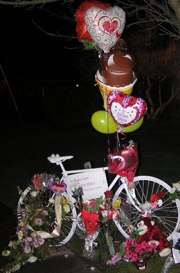
(Photos: Jim “K’Tesh” Parsons)
On February 11, 2008, 15-year old Beaverton high school student Austin Miller was collided with a TriMet bus when he merged from a sidepath on Murray Road into a bus stop on SW Farmington Road.
The tragedy sent shockwaves through the region. It raised questions about the legality of sidepaths, riding conditions in Beaverton, and more.
The crash (and perhaps the resulting lawsuit filed by Miller’s family in June) also spurred TriMet to take a serious look at they train bus operators and at where other other potential bus/bike conflict areas might exist.
TriMet found a willing partner in their new bike safety initiatives in the Bicycle Transportation Alliance (BTA). Nearly one year ago today, the BTA and TriMet launched a joint initiative to improve bus/bike safety.
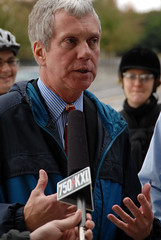
the opening of new bikeways
in the Rose Quarter Transit Center.
(Photo © J. Maus)
Yesterday, the BTA’s Michelle Poyourow took a look back at the results of that partnership. Writing on the BTA Blog, she wrote:
After the crash, TriMet instituted a training program for its bus operators on driving around bicyclists. By last fall, all 1,400 [bus operators] had passed through the two-hour class.
Poyourow also shared how the Miller death motivated TriMet to work with the BTA and the Portland Bureau of Transportation to install green-painted bikeways at the Rose Quarter Transit Center (a notorious bus/bike conflict area).
In addition, Poyourows writes that the BTA has stepped up their education efforts. At over 60 bike commuting workshops held since Austin Miller died, they’ve shared tips on how to safely ride around buses and they’ve gather data on where bus/bike conflicts occur through a survey that went out to 1,700 metro-area residents.
So what’s next on the BTA’s agenda for improving bus/bike safety? Read more of Poyourow’s article over on the BTA Blog.


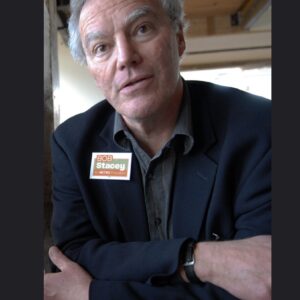

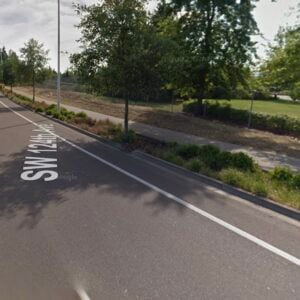
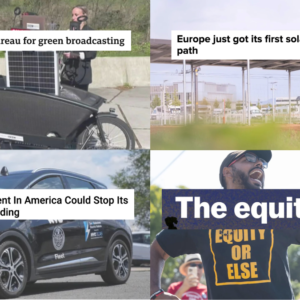
Thanks for reading.
BikePortland has served this community with independent community journalism since 2005. We rely on subscriptions from readers like you to survive. Your financial support is vital in keeping this valuable resource alive and well.
Please subscribe today to strengthen and expand our work.
We should also remember what the months-long investigation determined:
“Police said cyclist Austin Miller ran a traffic light at the intersection of Southwest Murray Boulevard and Farmington Road in Beaverton.
“MILLER STRUCK THE SIDE OF THE BUS behind the passenger entrance doors. The report said the boy went under the back wheels…
“The crash occurred because Austin Miller failed to stop his bike prior to entering the bike path.
“Miller was listening to an iPod portable music player at the time of the crash. A Beaverton city ordinance outlaws using a player while driving or riding a bike.”
Ride safe out there, people.
Was it really running a light? Austin was on the sidewalk, turning right, and presumably dropping off the curb into the bike lane/bus pull out.
Lots of cyclists would have done the same. Whether or not he was wearing the headphones or not, this intersection is seriously flawed. Despite the extra training for Tri-Met’s drivers, if unchanged, this location will probably kill again.
Nutz, hit reply before finishing…
+1 on that last line…
Ride safe out there people, And if you find something that isn’t safe, don’t sit there like a bump on a log, get up and speak up! Take photos, do research, make contacts, and get things resolved.
See Something? DO SOMETHING!
I’m glad that Trimet and the BTA are on good terms and are constantly pushing eachother to do things better.
Thanks, K’Tesh, for all your work out there. You really are a great example of an individual who has made bicycling better in their community. I’ve gotta start carrying a camera on my bike.
No more ghost bikes!
I’m not sure that you would be required to stop for that right hand turn from a bike path to a bike lane.
Buses are fairly long, and it is easy to be beside one when it starts to “come over”. It’s sort of like when an 18 wheeler takes a right turn.
Suggesting that we need to stop the “location” from killing is the kind of comment that makes the general public believe that many bikers are wacko.
There’s nothing wrong with the intersection. A teenager wasn’t paying attention, and ran into the side of a bus. Sad, but it happens.
It’s great the Tri-Met and the BTA did something about this, but the City of Beaverton seems to have taken no notice. It’s recently published transportation system plans show Murray Boulevard as having satisfactory bike support, claiming (falsely) that it has bike lanes from 26 to Scholl’s Ferry (this particular section between TV Highway and Farmington [where Austin was killed] is the one place without a bike lane).
I ride through there every day, and I honestly have no idea what the intended bicyclist behavior is.
I still feel sad about his.. life lost!
seems my little town doesnt like to listen
to its people. I have more buses to deal
with in wilsonville these days. ahhh!
this place is getting nuts, cell phoners
and red light runners. still waiting for a
call back.. ohh i will keep on tring to make the roads safe wherever i live!
so others are safe in the long haul!
careful the cagers are getting angry more and more!
Joe
Andy
…perhaps your local BAC should file suit with the city to bring up the facility to the TSP plan (or shred it and start over)
Put me in front of a big honkin’ bus instead of a caddy driven by a blind and deaf 89 year-old. Bigger payday for my estate, in case I get nailed! 😛
I used to be a long-time resident of Beaverton before I moved to Wa. State to work for REI in their Central Bicycle Shop at REI Headquarters. I moved back here after a year, but CHOSE TO NOT LIVE IN BEAVERTON BECAUSE IF WAS LESS SAFE TO RIDE THERE THAN WHEN I LEFT. I was resident in Multnomah County when Austin was killed. I have been car-free for over 12 years and therefore have a lot more experience in evaluating what does or does not constitute a safe-safe riding roadway design from a bicyclist’s perspective. While in Beaverton for over 8 years I was involved on a casual basis with Beaverton’s BAC and the Beaverton Bicycle Police unit. That said, to qualify my credentials, for those of you that don’t know me.
Let me start by saying that several serious errors may have occurred during the official investigations into the matter of Austin’s death. First, riding south on Murray, “as far to the right as practicable” a bicycle rider is confronted by signage prior to the corner of Farmington that directs them to leave the roadway via a curb cut and ride on the sidewalk. This is because the road is narrowed by sidewalk that does not exist on Murray prior to the corner. In our society, most people do what they are told to do on the road by directional signage. When I rode that way I did not enter the sidewalk, instead stayed in traffic as a vehicle, not a pedestrian, and “took the lane” continuing to the intersection. If the light was Red, as it was at the time of Austin’s last moments of life, I would come to a stop and make sure it was safe to make a right turn to head W on Farmington, or wait for a Green light to do so. I NEVER RIDE ON SIDEWALKS. Actuarial statistics by insurance companies prove beyond a shadow of a doubt that riding on sidewalks several things are happening. One, IF you are seen by an automobile driver, they assume you are going to remain on the sidewalk. Two, you are LESS LIKELY TO BE SEEN, as you are out of the sight path of a driver, and tend to disappear into the background visual noise of shrubbery, housing, business signage, etc. Thirdly, bicycle riders on sidewalks most dangerous moments and highest chance for contact with automobiles occur when crossing driveway cuts and when leaving the sidewalk to enter the street at intersections.
In the State of Oregon, when a bicycle is ridden on the sidewalk, they are really considered a pedestrian and by law are to ride at a speed no faster than a walking speed, apparently so as not to endanger pedestrians and also to lessen the probability of a collision with a vehicle at a driveway cut. They are also required to warn a pedestrian when closing and passing from behind said pedestrian. I have not seen anywhere in any ORS that it is required for a bicycle to come to a stop on a sidewalk at an intersection when remaining on the sidewalk and making a turn.
So much for the “…ran a red light” portion of the investigation.
The iPod thing: Clearly a violation of common sense and safety and at the moment Austin left the curb at the cutout, as directed by signage, a legal violation. A bicyclist’s ears are like a second set of eyes and you can “see” traffic that is out of your visual sight and I myself have been guilty of listening to music on only VERY RARE OCCASIONS, such as doing a ZooBomb, when the only other traffic around, late on a Sunday night on Fairview, are other bicycles and everyone anticipates pretty much what other riders will do. Any verbal warnings are usually shouted so loudly that they can be heard, like “CAR COMING”, “PEPPER”, etc.
Last point and this is the big crunch and the reason I NO LONGER PARTICIPATE IN BAC in any capacity nor will I have anything to do with anything Beaverton. The design of the intersection does not fall within the suggested intersection designs as set forth by the State of Oregon for an area as densely populated and trafficked as is Murray/Farmington. For the City of Beaverton to state that the intersection is poorly designed would be for them to admit liability and open up the City for suit. I stated this once here about 2-3 days after Austin’s death and was warned in no uncertain terms NOT to contact Austin’s relatives. I complied, but hoped that the thread would be noticed by them. To my knowledge it has not, or else the City would be included in their suit against TriMet.
There, I just opened myself up to more legal battles, but those of you that know me, know that I do not always do what I am told by Authorities, especially when I know that the Authorities are wrong. AND I have a good lawyer!
What’s so hard to understand about a “location” being a killer? Every day that you’re using the built infrastructure, you rely on it being designed correctly. You drive on a highway assuming that there isn’t a ditch dug across all lanes around the next bend. You approach a stoplight with the assumption that when it’s green for you, it’s red for the other direction. Yes, you are also on the alert for the unexpected, but when the design of the road is poor to begin with, the safety envelope you put around yourself just got a lot smaller.
A bike path that’s designed to feed traffic into a bike lane that immediately crosses bus traffic is just such a poor design. There’s no excuse for it.
Kurt, you are wrong on both your general point, and in the specific case.
I agree with Andy; the first time I rode there I was in Murray taking the lane at dusk and fearing for my safety. Had no idea I was ‘supposed to be’ up on the sidewalk, as an obscure sign with small verbose lettering instructs. While I was in the lane stopped at the light a motorist came to a screech inches behind me, apparently not having seen my multiple bright blinking lights. I swear the guy would have run into the car in front of me had I not been there!
Anyway, I’m told (by my cyclist/Project Engineer friend) that the MUP is controlled by Washington County, not by the city of Beaverton, and that St. Mary’s had refused to grant sidewalk easement into their property when the bike lanes were first put in.
Other than that, I found the bike lanes on Murray to be the widest and best maintained I’ve ever seen, though they could use some green or blue at certain intersections where the lanes become de facto right-turn lanes for motorists (yeah, we know it’s legal in California, but you’re not there anymore).
Kid being stupid died, as kids his age are, end of story.
No amount of money donated to useless organizations like the BTA will bring him back. The only thing people can do is take responsibility for their own kids’ behavior and hope that it takes eventually.